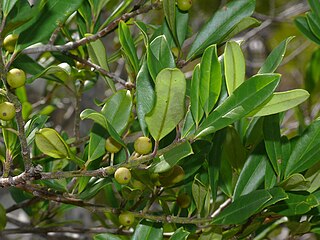
Ilex cassine is a holly native to the southeastern coast of North America, in the United States from Virginia to southeast Texas, in Mexico in Veracruz, and in the Caribbean on the Bahamas, Cuba, and Puerto Rico. It is commonly known as dahoon holly or cassena, the latter derived from the Timucua name for I. vomitoria.

Ilex verticillata, the winterberry, is a species of holly native to eastern North America in the United States and southeast Canada, from Newfoundland west to Ontario and Minnesota, and south to Alabama.

Ilex montana, the mountain winterberry, is a species of holly native to the Eastern United States, ranging along the Appalachian Mountains from southeast Massachusetts to northeast Alabama and northern Georgia. Synonyms include Ilex monticola.
Eschweilera sclerophylla is a species of woody plant in the family Lecythidaceae. It is found only in Colombia.
Ilex caniensis is a species of plant in the family Aquifoliaceae. It is endemic to Peru. Some authorities have it as a synonym of Ilex uniflora.
Ilex grandiflora is a species of plant in the family Aquifoliaceae. It is endemic to Peninsular Malaysia. It is threatened by habitat loss.
Ilex illustris is a species of plant in the family Aquifoliaceae. It is endemic to Peninsular Malaysia.
Ilex ovalis is a species of flowing plant in the holly family Aquifoliaceae. It is native to Ecuador and Peru.
Ilex maingayi is a species of plant in the family Aquifoliaceae. It is endemic to Malaysia. It is threatened by habitat loss.
Ilex marginata is a species of plant in the family Aquifoliaceae. It is endemic to Venezuela. Otherwise known as the variegated English Holly. The female Ilex Marginata produces inedible small berries. The plant is popular for decoration along the midline of the United States where the climate seems to agree with the plant better. The Ilex marginata produces small white flowers. The hedge shape of the plant and its color scheme makes it a popular holiday decoration.
Ilex patens is a species of plant in the family Aquifoliaceae. It is endemic to Peninsular Malaysia. It is threatened by habitat loss.
Ilex pauciflora is a species of plant in the family Aquifoliaceae. It is a tree endemic to Peninsular Malaysia. It is threatened by habitat loss.
Ilex praetermissa is a species of plant in the family Aquifoliaceae. It is endemic to Klang Gates Quartz Ridge, Malaysia. It is threatened by habitat loss.
Ilex tahanensis is a species of plant in the family Aquifoliaceae. It is a tree endemic to Peninsular Malaysia.
Ilex ternatiflora is a possibly extinct plant in the family Aquifoliaceae. It was endemic to Cuba.
Ilex tolucana is a tree species in the family Aquifoliaceae, native to the mountains of Mexico and Central America from east-central Sonora south to El Salvador.
Ilex venulosa is a species of plant in the family Aquifoliaceae. It is endemic to Arunachal Pradesh.

Ilex, or holly, is a genus of over 560 species of flowering plants in the family Aquifoliaceae, and the only living genus in that family. Ilex has the most species of any woody dioecious angiosperm genus. The species are evergreen or deciduous trees, shrubs, and climbers from tropics to temperate zones worldwide. The type species is Ilex aquifolium, the common European holly used in Christmas decorations and cards.

Ilex coriacea, sometimes known as large gallberry or sweet gallberry, is a shrub in the Holly family native to coastal areas in the United States from Virginia to Texas. It exists primarily as an understory plant in pine forests, and is sometimes stimulated by regular controlled burnings.
As of July 2016, the International Union for Conservation of Nature (IUCN) lists 238 conservation dependent species. 0.29% of all evaluated species are listed as conservation dependent. The IUCN also lists seven subspecies and five varieties as conservation dependent.





